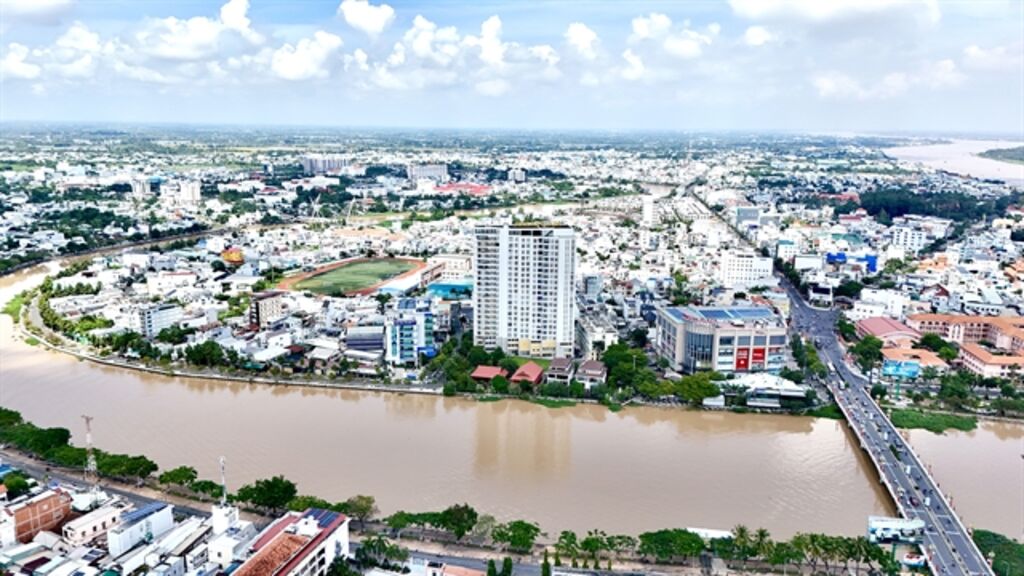 |
| Photo shows a corner of Long Xuyen ward in the Mekong Delta province of An Giang, the ward is striving to become the trading hub of the Long Xuyen Quadrangle.-Photo: VNS/VNA |
The Government has set national development goals for the decade ahead, aiming to raise per capita GDP to around USD 8,500 by 2030.
The target is set under Resolution No. 306/NQ-CP recently issued by the Government on adjustments to the national master plan for the 2021-30 period, a vision towards 2050.
Under the plan, the services sector is expected to account for over 50 percent of GDP, industry and construction for more than 40 percent, while agriculture, forestry and fisheries for under 10 percent.
Average annual labor productivity growth is targeted at about 7 percent for 2021-30, rising to over 8.5 percent between 2026 and 2030.
Total factor productivity (TFP) is projected to contribute more than 55 percent to overall growth.
The resolution calls for the rapid development of digital and data infrastructure to underpin national digital transformation, build a digital government, digital economy and digital society, with the digital economy expected to account for around 30 percent of GDP.
Social targets
By 2030, Vietnam aims to maintain a replacement-level fertility rate of 2.1 children per woman and a population of about 105 million.
The Human Development Index (HDI) is expected to reach 0.78 and average life expectancy around 75.5 years.
The proportion of agricultural labor will fall below 20 percent of the workforce, while job quality and employment stability are to be improved.
Education is to reach an advanced regional standard, with Vietnam striving to be among the top 10 Asian countries for higher education systems.
At least eight universities are expected to rank among Asia’s top 200, and at least one institution among the world’s top 100 in specific disciplines, according to reputable international rankings.
Healthcare services are to be upgraded to regional advanced standards, with a comprehensive national healthcare network ensuring equitable, high-quality and efficient services.
The plan also stresses building a vibrant cultural environment, preserving and promoting national identity, and developing cultural industries.
Every province and centrally governed city is to have at least three key cultural institutions of a cultural or cultural-arts center, a museum and a library.
National growth hubs
The resolution sets out a framework for socio-economic spatial development, including regional planning, inter-regional linkages, and the creation of national growth poles and economic corridors.
The northern growth region will center on Hanoi and areas along Ring Roads 4 and 5, National Highways 5 and 18, and expressways CT01, CT04, CT05, CT07 and CT09, encompassing localities of Hai Phong, Bac Ninh, Thai Nguyen, Phu Tho, Ninh Binh, Hung Yen and Quang Ninh.
Hanoi will serve as the growth pole.
The northern growth region will lead the way in high-quality human resources, science and technology, innovation, and the digital economy as well as functioning as the national center for economy, culture, education, healthcare and innovation.
The southern growth region will encompass areas along National Highways 22, 13, 1 and 51, the western North-South Expressway and Ring Road 4, running through HCM City, Dong Nai province and Tay Ninh province.
HCM City will act as the growth pole.
The southern growth region will steer the region and the nation in economy, finance, trade, services, healthcare, education and technology.
The Government plans to develop a regional innovation ecosystem, promote digital transformation, and establish an international financial center in HCM City to position Vietnam within the global financial network.
The central growth region will include coastal areas of localities of Thua Thien-Hue, Da Nang, Quang Ngai and Gia Lai, with Da Nang as the growth pole.
The focus will be on developing coastal urban centers, marine tourism hubs, petrochemical and energy industries, automotive manufacturing and supporting industries, and expanding seaports, airports and logistics services.
The Mekong Delta growth region will revolve around Can Tho City and the provinces of An Giang, Vinh Long and Dong Thap, connected by key expressways such as Can Tho-Vinh Long, An Huu-Cao Lanh, Cao Lanh-Rach Soi and Chau Doc-Can Tho-Soc Trang, Ha Tien-Rach Gia-Bac Lieu as well as Phu Quoc special zone.
Can Tho will serve as the growth pole.
The region aims to become a hub for services, tourism, logistics and agro-industry, and a national center for agricultural science, technology and innovation.
Phu Quoc island is to be developed into an international eco-tourism and services center, linking Vietnam with major regional and global economic hubs.
The North-Central growth region will cover areas along the eastern North-South Expressway, National Highway 1 and the coastal route, connected with major urban and coastal economic zones of Thanh Hoa, Nghe An and Ha Tinh.
The region will become a national center for petrochemical refining, metallurgy, mechanical engineering and automobile manufacturing, while also fostering emerging industries such as electronics, semiconductors, artificial intelligence and digital technology to drive regional socio-economic development.
The Government will also gradually establish growth areas in the south central coast and Central Highlands regions, focusing on Khanh Hoa, Lam Dong and neighboring provinces.- (VNS/VLLF)









